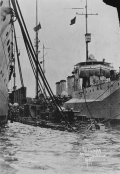Click On Image
For Full Size Image |
Size |
Image Description |
Contributed
By And/Or Copyright |
 |
56k | John Ericsson, one of the 19th Century's most creative engineers and inventors, was born on 31 July 1803 in Sweden. As a youth, he joined the Swedish Army, which recognized his talents and put him to work on topographical duties. Ericsson left the Army in 1826 and moved to England, where he pursued a variety of engineering projects, among them the use of screw propellers on ships, the development of extraordinarly large guns and the creation of engines driven by hot air instead of steam. Ericsson's work attracted the attention Robert F. Stockton, an influential and progressive U.S. Navy officer, who encouraged him to relocate to the United States. During the early 1840s, the two designed a screw-propelled warship, which was commissioned in 1843 as USS Princeton, armed with heavy guns of their devising. The tragic explosion of one of these guns, and efforts to improperly assign the blame to Ericsson, led the strong-willed engineer to redirect his creativity into civilian fields, which he pursued successfully during the 1840s and 1850s. The outbreak of the American Civil War brought John Ericsson back into formal contact with the Navy, when he designed and produced USS Monitor, a revolutionary armored ship carrying her guns in a rotating turret. Monitor's successful battle with the Confederate ironclad Virginia on 9 March 1862 made Ericsson a great hero in the North. For the remainder of the conflict, he was actively involved in designing and building a large series of "Monitor"-type turret ships for the Navy. Ericsson continued his work on maritime and naval technology after the Civil War, producing ships for foreign navies and experimenting with submarines, self-propelled torpedoes and heavy ordnance. He remained active until his death in New York City on 8 March 1889. In August 1890, following a memorial service at New York, his body was placed on board the cruiser Baltimore, which carried him across the Atlantic to his native Sweden for burial. Photo #: NH 305. John Ericsson (1803-1889) photograph taken in 1862. The original print is mounted on a Carte de Visite. U.S. Naval Historical Center Photograph. | Bill Gonyo |
 |
60k | Undated stereograph, location unknown. | Tommy Trampp |
 |
105k | Speed trials, 10 May 1915. USN photo. | Joe Radigan |
 |
525k | USS Ericsson (Destroyer # 56), Steaming at 19.93 knots during Run No. 10 of builder's trials, 18 May 1915. Her armament has not yet been installed. U.S. Naval History and Heritage Command Photo #: NH 1372. Presented in larger than normal scale so you can see the detail. | Robert Hurst |
 |
96k | USS Melville (Destroyer Tender # 2) tending U.S. Navy destroyers at Queenstown, Ireland, 1917. The destroyers present include (from left to right): USS Jacob Jones (Destroyer # 61); USS Ericsson (Destroyer # 56); USS Wadsworth (Destroyer # 60); and an unidentified ship. U.S. Naval Historical Center Photograph. | Fred Weiss |

| 79k | Photo #: NH 56378, USS Benham (Destroyer # 49) in port with her main deck nearly awash, after she was rammed by HMS Zinnia during World War I. She is tied up between USS Ericsson (Destroyer # 56), at right, and another ship. Collection of Lieutenant Commander Philip W. Yeatman, USN (Retired).
U.S. Naval Historical Center Photograph. | Tony Cowart |

| 91k | Photo #: NH 103746, USS Benham (Destroyer # 49) in port with her main deck nearly awash, after a collision with HMS Zinnia during World War I. She is tied up between USS Ericsson (Destroyer # 56), at right, and another ship. Collection of Lieutenant Commander Philip W. Yeatman, USN (Retired).
U.S. Naval Historical Center Photograph. | Tony Cowart |

| 80k | Photo #: NH 91644, USS Ericsson (Destroyer # 56) photographed from USS Mercury (ID # 3012), while escorting her in French waters, 1918. Note Ericsson's pattern camouflage. Courtesy of James Russell, 1980. U.S. Naval Historical Center Photograph. | Paul Rebold |

0505610 |
189k | RPPC of Ericsson (Destroyer No. 56), McKee (Destroyer No. 87) and Walker (Destroyer No. 163) moored at an unknown port, probably in the Carribbean, circa 1919. | Dave Wright |

| 46k | Photo #: NH 103514-F, USS Ericsson (DD-56) in the North River off New York City, 20 May 1921. Cropped from NH 103514, a panoramic photograph by Himmel and Tyner, New York. U.S. Naval Historical Center Photograph. | Paul Rebold |
 |
86k | Destroyer Squadron 14 in the North River, off New York City, 20 May 1921. Panoramic photograph by Himmel and Tyner, New York. U.S. Navy ships present are (from left to right): USS Cummings (DD-44); USS Wainright (DD-62); USS Parker (DD-48); USS Balch (DD-50); USS McDougal (DD-54); USS Ericsson (DD-56) and USS Dixie (AD-1), squadron flagship. Note what appears to be a yacht club in the lower left (Photo No NH 103514). | Robert Hurst |
 |
30k | On Coast Guard service during the Prohibition Era, from the Official Coast Guard Website. | Mike Green |
 |
108k | On Coast Guard service May 27 1930 at BGoston Navy Yard. Leslie Jones Collection, Boston Public Library. | Ed Zajkowski |

